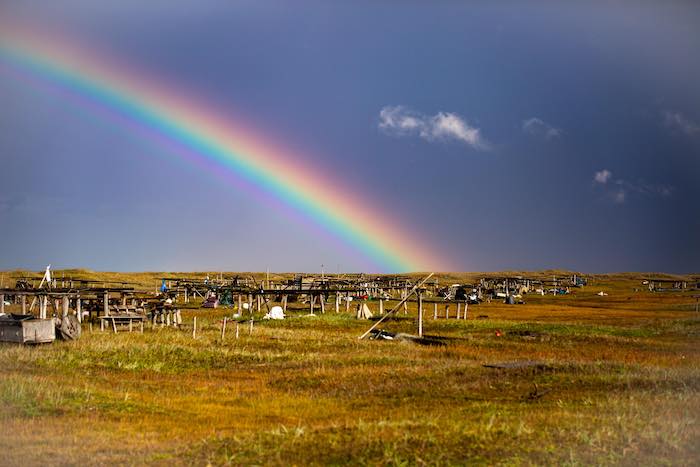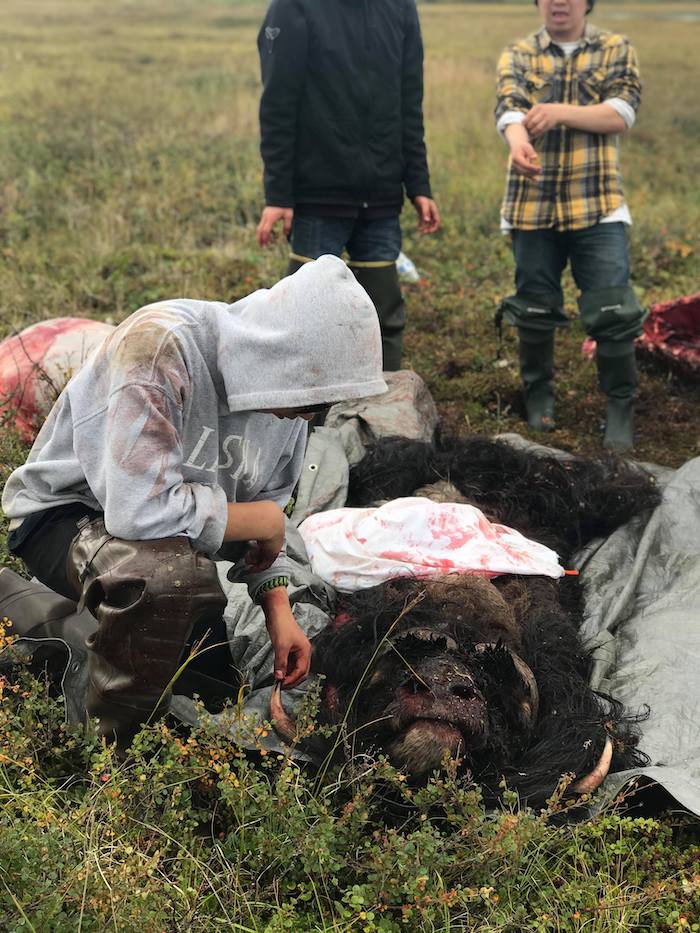By: Elizabeth Marino, Associate Professor of Anthropology and Sustainability, Oregon State University-Cascades
Background
In 2019, Annie Weyiouanna, Siġvanna (Megan) Topkok, Julie Raymond-Yakoubian, Alessandra Jerolleman, and I, Elizabeth Marino, received funding from the Arctic Social Sciences Program at the National Science Foundation to investigate options, obstacles, and opportunities to climate change adaptation from a legal and Inupiat perspective. Our project, Adaptations to Repetitive Flooding: Understanding Cross-Cultural and Legal Possibilities for Long-Term Solutions to Flooding Disaster, arose from the need to understand policy and legal options for communities like Shishmaref, Alaska (Kigiqtaq) who face repetitive flooding events that threaten lives, infrastructure, and subsistence-use areas of the island homeland. Under rapidly changing climate conditions, these policy options, including relocation options and their applicability, availability, and impact across different community-types, constitute both basic and use-inspired research. There are enormous gaps in the social science and policy literature about whether relocation funding is available to these communities; will become available in the future; or even, whether relocations are adaptive or maladaptive from a long-term social and economic standpoint. Relocation as maladaptation seems counterintuitive when we consider the risks generated by repetitive flooding, and many scientists agree that relocation away from coastal areas will be necessary due to sea-level rise and other climate-generated hazards; however, some seemingly adaptive strategies (such as relocation) can create other types of social risk.
We hypothesized, based on observations from development-induced displacement, that these risks would increase when policies were misaligned with local desires and needs. We aim to examine what constitutes culturally relevant relocation from the perspective of Kigiqtamiut residents. We hypothesize that "adaptation" is distinct from "coping," the latter being bare survival, while the former is a subjective experience of well-being, following changes in lifeways in response to social and/or ecological pressure. By analyzing adaptation from a local perspective, we will better understand how cultural subjectivities interact with disaster response to inform culturally relevant adaptation strategies.
Our core team was made of the disciplinary and local experts needed to address these complex social phenomena. Annie Weyiouanna is from Shishmaref, and has held numerous leadership positions within the community. I (Elizabeth) am an anthropologist at Oregon State University. Siġvanna (Megan) Topkok is a staff attorney at the Indigenous non-profit Kawerak, Inc. Alessandra Jerolleman is an emergency management and disaster policy specialist who works in Louisiana, and Julie Raymond-Yakoubian is a social science specialist at Kawerak, Inc.

"It's so awesome, because you've got the rainbow, but you've got the racks with all the meat. It's not a pot of gold, but it's a pot of food. That's the way I was looking at it, you're not getting gold, but you're getting food for the winter. It's food for the future. I'd rather have food instead of gold. That's the way it was—exactly. It was perfect because you can see it's dark on one side and light on one side—you've got six different colors of the rainbow. Taste the rainbow, literally. You are hanging ugruk on there—basically you're tasting the rainbow." – Dennis Davis, Kigiqtamiut Inupiat artist and videographer.
Research Objectives, Co-Production, and Methodological Experiments
Our objectives for the project were three-fold. First, we wanted to analyze case studies, federal legislation, case law, and constitutional law to map what is possible and what is not possible in the attempt to fund relocation and site expansion as an adaptation strategy to repetitive flooding. Second, we wanted to analyze what constitutes culturally appropriate relocation and site expansion as adaptation from a Kigiqtamiut Inupiat perspective. Third, we wanted to triangulate the policy possibilities for adaptation with the culturally appropriate possibilities for adaptation. This triangulation was essential for understanding what adaptive pathways would decrease risk from flooding without increasing other social risks.
Triangulating local and policy options is also part of what we’re using to develop new social theory. One of the research questions we have is about how ethnocentric assumptions become codified into law. In other words, we expect that there are cultural assumptions about human/land relationships that necessarily become enacted within legal structures. We know that disaster impacts are inequitably distributed across different neighborhoods and communities linked to long-standing oppression and social inequity. We hypothesized that there are also philosophical and deeply held cultural assumptions, articulated within the legal structures that shape disaster outcomes, that privilege people who share those beliefs, and exacerbate harm in communities who organize differently. For example, we are working on a book now that describes how property ownership structures relocation options; and that property is premised on individual decision-making. This complicates relocation planning for communities who wish to stay together.

"My son just paying his respects to the musk ox. I thought that was an awesome shot. He's thanking the musk ox, and just like me, I thank every animal after I get them. I thank them for feeding my family. It's the only way to do it. And then we had to haul this back ¼ mile to the boat, and so that really sucked. This time we butchered this one right there and haul it out. It was a big old bull and you really don't want to get a musk ox the opening of the season—you want to get a musk ox in the winter time." – Dennis Davis, Kigiqtamiut Inupiat artist and videographer.
Another innovation for the project was the goal of a truly co-produced piece of social research. Annie and I have worked together and been friends ever since I did my dissertation research in Shishmaref. From the beginning of this project, we discussed how many outsiders had told the story of Shishmaref (documentary film-makers, journalists, researchers) and that it was important for people in Shishmaref to tell their own story. As our project evolved (and did some COVID pivoting) we decided part of that authentic story telling would be an art exhibit documenting local perspectives of change and resilience. We partnered with an artist and tribe in Louisiana, and a Shishmaref artist named Dennis Davis and are in the process of creating an online museum exhibit featuring this work. For a sneak peak of the work, still in progress, please see, "Our Knowledge is Power: The Cultures of Beauty and Survival in Isle de Jean Charles, Louisiana and Shishmaref, Alaska". Finally, we are piloting a methodology where all ethnographic research is being collected by community members, with community members, to be owned by the community. We have partners with tribal members in Louisiana for cross-site comparison, and Annie is leading the effort in Shishmaref. For the social scientists out there, this has been an Institutional Review Board (IRB) nightmare, but we are hopeful that this new methodology is a way to prevent extractive research practices.
For more information, please see our research grant website, Repetitive Flooding, Resettlement, Site Expansion, and the Law.
About the Author
 Elizabeth Marino, PhD is an Associate Professor of anthropology and sustainability at Oregon State University-Cascades. She is interested in the relationships among climate change, vulnerability, slow and rapid onset disasters, human migration, and sense of place. Elizabeth is the lead author on the Human Social Systems Chapter of the forthcoming National Climate Assessment, and was a science delegate at the Second Arctic Science Ministerial. Her book “Fierce Climate, Sacred Ground: An Ethnography of Climate Change in Shishmaref, Alaska” was released in 2015.
Elizabeth Marino, PhD is an Associate Professor of anthropology and sustainability at Oregon State University-Cascades. She is interested in the relationships among climate change, vulnerability, slow and rapid onset disasters, human migration, and sense of place. Elizabeth is the lead author on the Human Social Systems Chapter of the forthcoming National Climate Assessment, and was a science delegate at the Second Arctic Science Ministerial. Her book “Fierce Climate, Sacred Ground: An Ethnography of Climate Change in Shishmaref, Alaska” was released in 2015.
